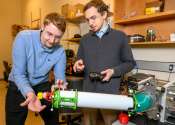Research shows electric flare stack technology significantly reduces carbon emissions
Researchers have used new technology to create an electric flare stack that significantly reduces CO2 emissions compared to gas flares that are currently used by oil refineries to control pollution.
Dec 12, 2023
0
18









